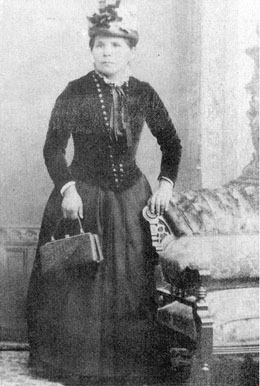Kate Kanim Borst was a Native American woman who was the third wife of Snoqualmie Valley settler Jeremiah Borst. During her lifetime, she witnessed the transformation of the valley from prairies and Indian encampments to the beginnings of suburbia.
Born of Royalty
She was born Kate Kanim Smith in 1855 at Pleasant Hill near Tolt. Her father was a medicine man. Kate was a half-sister to Snoqualmie Chief Jerry Kanim, and also was related to Chief Seattle, leader of the Duwamish and Suquamish tribes. Her lineage is comparable to royalty by Western standards.
When Kate was a child, her mother died, and Kate was taken to her grandmother's home. As a young woman, she married a white man with whom she had two children. He later abandoned her, and in 1880 she married Jeremiah Borst. Borst was the first permanent white settler in the region and is considered to be the father of the Snoqualmie valley community.
Bridging Cultures
Mrs. Borst adapted quite well to Western customs. She enjoyed fine clothing and the Borsts even hired Indian servants to help with household chores. Kate, being a tribal princess, was already accustomed to having servants perform these tasks.
Although she took on the role of a pioneer's wife, she never lost her Native heritage. Once she fell ill, and three Seattle doctors were unable to help her. Indian medicine men came to her house, but Mr. Borst refused them. When her illness worsened and the doctors could do no more, he consented to allow the Indian healers a chance to save her.
They placed her in a canoe and carried her down river to Indian Bill, a well-known healer. She lay on his floor, with fire on both sides of her. Indian Bill attempted to draw the evil spirits out of her, but she was too ill and it didn’t work. Another medicine man came to help. At this point Indian Bill motioned over her prone body, proclaimed that he had something, and grabbed it with his hands. At this, Kate opened her eyes wide and she quickly recovered. Old Bill had the spirit cut in two and thrown into the fire.
Thankful and relieved, her husband paid the Indian doctor $100, a sizable sum in those days. Kate also attributed her recovery to the power of her father, which flowed through her. "The tamanowos of my father was in me fighting with that of someone else for possession," she said, "When the bad tamanowos was taken out I had no more pain." (Hill, Snoqualmie Valley,10)
Perseverance
Her husband died in 1890, and Kate received little from his estate. Still, she persevered, relying on her own resources to get by. She later remarried for a short time and moved to Redmond, but always went by the name Borst.
Once, she was asked to christen the wooden boat Snoqualmie for the United States Emergency Fleet Corporation and received a gold watch from the builder. Her later years in Redmond were spent tending her garden and visiting with her many friends. Her knowledge of the medicinal use of herbs was of much use to neighbors during times of sickness.
"Hold Yourself Erect"
Mrs. Borst never learned to read or write, but was a fluent speaker of both Chinook and English. She was an invaluable resource to early local historians, always willing to share stores and to act as a bridge between two cultures.
Kate Borst died in 1938 at the age of 83. A few years before her death, a feature article about her appeared in the local newspaper. When asked what advice she could give to the younger generation, she replied "Hold yourself erect. Walk straight" (East Side Journal).

